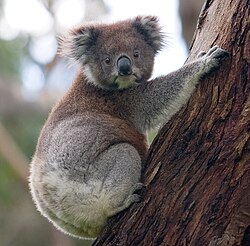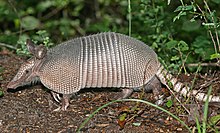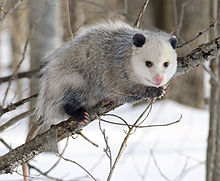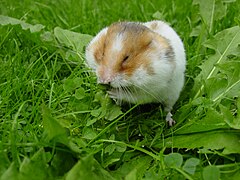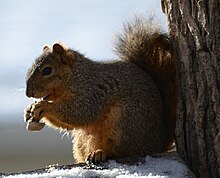Sleep in animals refers to a behavioral and physiological state characterized by altered consciousness, reduced responsiveness to external stimuli, and homeostatic regulation. Sleep appears to be a requirement for all mammals and most other animals; rats kept from sleeping die within a couple of weeks. The fact about sleep in animals is: There are a lots of animal spend more than 80% of their time sleeping every day. And here in this article Top 10 Most Sleepiest Animals On Earth listed. Read on:
The koala (Phascolarctos cinereus) is an arboreal herbivorous marsupial native to Australia. It is the only extant representative of the family Phascolarctidae and its closest living relatives are the wombats. The koala is found in coastal areas of the mainland's eastern and southern regions, inhabiting Queensland, New South Wales, Victoria, and South Australia. It is easily recognisable by its stout, tailless body and large head with round, fluffy ears and large, spoon-shaped nose. The koala has a body length of 60–85 cm (24–33 in) and weighs 4–15 kg (9–33 lb). They sleep upto 20 hours in a day.
2. Lion
The lion (Panthera leo) is one of the big cats in the genus Panthera and a member of the family Felidae. The commonly used term African lion collectively denotes the several subspecies found in Africa. With some males exceeding 250 kg (550 lb) in weight, it is the second-largest living cat after the tiger. Wild lions currently exist in sub-Saharan Africa and in India. The male lion is easily recognized by its mane, and its face is one of the most widely recognized animal symbols in human culture. They sleep upto 20 hours in a day.
3. Sloth
Slothsare medium-sized mammals belonging to the families Megalonychidae and Bradypodidae, classified into six species. They are part of the order Pilosa and are therefore related to anteaters, which sport a similar set of specialized claws. Extant sloths are arboreal (tree-dwelling) residents of the jungles of Central and South America, and are known for being slow-moving, hence named "sloths". Extinct sloth species include many megafaunal ground sloths, some of which attained the size of elephants, as well as a few species of marine sloths. Sloths make a good habitat for other organisms, and a single sloth may be home to moths, beetles, cockroaches, ciliates, fungi, and algae. They sleep upto 20 hours in a day.
4. Armadillo
Armadillos are New World placental mammals with a leathery armour shell. Chlamyphoridae and Dasypodidae are the only surviving families in the order Cingulata, part of the superorder Xenarthra, along with the anteaters and sloths. About 9 extant genera and 21 extant species of armadillo have been described, some of which are distinguished by the number of bands on their armour. Their average length is about 75 cm (30 in), including tail. The giant armadillo grows up to 150 cm (59 in) and weighs up to 54 kg (119 lb), while the pink fairy armadillo is a diminutive species, with an overall length of 13–15 cm (5–6 in). All species are native to the Americas, where they inhabit a variety of different environments. They sleep upto 19 hours in a day.
5. Opossum
The opossums, also known by their scientific name Didelphimorphia make up the largest order of marsupials in the Western Hemisphere, including 103 or more species in 19 genera. Of South American ancestry, they entered North America following the connection of the two continents. Their unspecialized biology, flexible diet, and reproductive habits make them successful colonizers and survivors in diverse locations and conditions. When threatened or harmed, they will "play dead", mimicking the appearance and smell of a sick or dead animal. This physiological response is involuntary (like fainting), rather than a conscious act. They sleep upto 19 hours in a day.
6. Owl Monkey
The night monkeys, also known as the owl monkeys or douroucoulis, are the members of the genus Aotus of New World monkeys (monotypic in family Aotidae). The only nocturnal monkeys, they are native to Panama and much of tropical South America. Night monkeys constitute one of the few monkey species that are affected by the often deadly human malaria protozoan Plasmodium falciparum, making them useful as non-human primate experimental models in malaria research. They sleep upto 17 hours in a day.
7. Lemur
Lemurs are a clade of strepsirrhine primates endemic to the island of Madagascar. The word "lemur" derives from the word lemures (ghosts or spirits) from Roman mythology and was first used to describe a slender loris due to its nocturnal habits and slow pace, but was later applied to the primates on Madagascar. As with other strepsirrhine primates, such as lorises, pottos, and galagos (bush babies), lemurs share resemblance with basal primates. In this regard, lemurs are often confused with ancestral primates, when in actuality, lemurs did not give rise to monkeys and apes, but evolved independently. They sleep upto 16 hours in a day.
8. Hamster
Hamsters are rodents belonging to the subfamily Cricetinae. The subfamily contains about 25 species, classified in six or seven genera. They have become established as popular small house pets, and partly because they are easy to breed in captivity, hamsters are often used as laboratory animals. In the wild, hamsters are crepuscular and remain underground during the day to avoid being caught by predators. They feed primarily on seeds, fruits, and vegetation, and will occasionally eat burrowing insects. They have elongated cheek pouches extending to their shoulders in which they carry food back to their burrows. They sleep upto 14 hours in a day.
9. Squirrel
Squirrels are members of the family Sciuridae, consisting of small or medium-size rodents. The family includes tree squirrels, ground squirrels, chipmunks, marmots (including woodchucks), flying squirrels, and prairie dogs. Squirrels are indigenous to the Americas, Eurasia, and Africa, and have been introduced to Australia. The earliest known squirrels date from the Eocene and are most closely related to the mountain beaver and to the dormouse among living rodent families. They sleep upto 13 hours in a day.
10. Cat
The cat (Felis catus) is a small, typically furry, carnivorous mammal. They are often called house cats when kept as indoor pets or simply cats when there is no need to distinguish them from other felids and felines. Cats are often valued by humans for companionship and for their ability to hunt vermin. There are more than 70 cat breeds; different associations proclaim different numbers according to their standards. They sleep upto 12 hours in a day.
So what you think about this list, don't forget to mention :)
Top 10 Most Sleepiest Animals On Earth
1. KoalaThe koala (Phascolarctos cinereus) is an arboreal herbivorous marsupial native to Australia. It is the only extant representative of the family Phascolarctidae and its closest living relatives are the wombats. The koala is found in coastal areas of the mainland's eastern and southern regions, inhabiting Queensland, New South Wales, Victoria, and South Australia. It is easily recognisable by its stout, tailless body and large head with round, fluffy ears and large, spoon-shaped nose. The koala has a body length of 60–85 cm (24–33 in) and weighs 4–15 kg (9–33 lb). They sleep upto 20 hours in a day.
2. Lion
The lion (Panthera leo) is one of the big cats in the genus Panthera and a member of the family Felidae. The commonly used term African lion collectively denotes the several subspecies found in Africa. With some males exceeding 250 kg (550 lb) in weight, it is the second-largest living cat after the tiger. Wild lions currently exist in sub-Saharan Africa and in India. The male lion is easily recognized by its mane, and its face is one of the most widely recognized animal symbols in human culture. They sleep upto 20 hours in a day.
3. Sloth
Slothsare medium-sized mammals belonging to the families Megalonychidae and Bradypodidae, classified into six species. They are part of the order Pilosa and are therefore related to anteaters, which sport a similar set of specialized claws. Extant sloths are arboreal (tree-dwelling) residents of the jungles of Central and South America, and are known for being slow-moving, hence named "sloths". Extinct sloth species include many megafaunal ground sloths, some of which attained the size of elephants, as well as a few species of marine sloths. Sloths make a good habitat for other organisms, and a single sloth may be home to moths, beetles, cockroaches, ciliates, fungi, and algae. They sleep upto 20 hours in a day.
4. Armadillo
Armadillos are New World placental mammals with a leathery armour shell. Chlamyphoridae and Dasypodidae are the only surviving families in the order Cingulata, part of the superorder Xenarthra, along with the anteaters and sloths. About 9 extant genera and 21 extant species of armadillo have been described, some of which are distinguished by the number of bands on their armour. Their average length is about 75 cm (30 in), including tail. The giant armadillo grows up to 150 cm (59 in) and weighs up to 54 kg (119 lb), while the pink fairy armadillo is a diminutive species, with an overall length of 13–15 cm (5–6 in). All species are native to the Americas, where they inhabit a variety of different environments. They sleep upto 19 hours in a day.
5. Opossum
The opossums, also known by their scientific name Didelphimorphia make up the largest order of marsupials in the Western Hemisphere, including 103 or more species in 19 genera. Of South American ancestry, they entered North America following the connection of the two continents. Their unspecialized biology, flexible diet, and reproductive habits make them successful colonizers and survivors in diverse locations and conditions. When threatened or harmed, they will "play dead", mimicking the appearance and smell of a sick or dead animal. This physiological response is involuntary (like fainting), rather than a conscious act. They sleep upto 19 hours in a day.
6. Owl Monkey
The night monkeys, also known as the owl monkeys or douroucoulis, are the members of the genus Aotus of New World monkeys (monotypic in family Aotidae). The only nocturnal monkeys, they are native to Panama and much of tropical South America. Night monkeys constitute one of the few monkey species that are affected by the often deadly human malaria protozoan Plasmodium falciparum, making them useful as non-human primate experimental models in malaria research. They sleep upto 17 hours in a day.
7. Lemur
Lemurs are a clade of strepsirrhine primates endemic to the island of Madagascar. The word "lemur" derives from the word lemures (ghosts or spirits) from Roman mythology and was first used to describe a slender loris due to its nocturnal habits and slow pace, but was later applied to the primates on Madagascar. As with other strepsirrhine primates, such as lorises, pottos, and galagos (bush babies), lemurs share resemblance with basal primates. In this regard, lemurs are often confused with ancestral primates, when in actuality, lemurs did not give rise to monkeys and apes, but evolved independently. They sleep upto 16 hours in a day.
8. Hamster
Hamsters are rodents belonging to the subfamily Cricetinae. The subfamily contains about 25 species, classified in six or seven genera. They have become established as popular small house pets, and partly because they are easy to breed in captivity, hamsters are often used as laboratory animals. In the wild, hamsters are crepuscular and remain underground during the day to avoid being caught by predators. They feed primarily on seeds, fruits, and vegetation, and will occasionally eat burrowing insects. They have elongated cheek pouches extending to their shoulders in which they carry food back to their burrows. They sleep upto 14 hours in a day.
9. Squirrel
Squirrels are members of the family Sciuridae, consisting of small or medium-size rodents. The family includes tree squirrels, ground squirrels, chipmunks, marmots (including woodchucks), flying squirrels, and prairie dogs. Squirrels are indigenous to the Americas, Eurasia, and Africa, and have been introduced to Australia. The earliest known squirrels date from the Eocene and are most closely related to the mountain beaver and to the dormouse among living rodent families. They sleep upto 13 hours in a day.
10. Cat
The cat (Felis catus) is a small, typically furry, carnivorous mammal. They are often called house cats when kept as indoor pets or simply cats when there is no need to distinguish them from other felids and felines. Cats are often valued by humans for companionship and for their ability to hunt vermin. There are more than 70 cat breeds; different associations proclaim different numbers according to their standards. They sleep upto 12 hours in a day.
So what you think about this list, don't forget to mention :)

